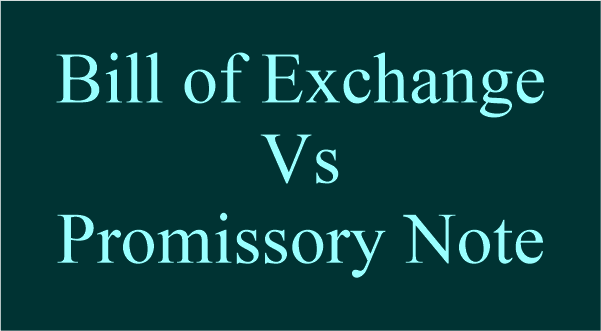Difference between Promissory Notes and Bills of ExchangeA commitment to pay a certain sum of money to the bearer/assignee at a specific time or upon demand is contained in a signed document known as a "negotiable instrument." These devices can be transferred, allowing the individual or organization to use them as best suits their needs. There are three categories of negotiating instruments: bills of exchange, cheques, and promissory notes. In this article, the terms "promissory note" and "promissory note" will be defined briefly, along with some of their key differences. 
Promissory NoteA promissory note is an official document that a person or business entity issues pledging to pay money. The payments may be sent on a regular or one-time basis and may be made in letter form or other writing. A promissory note is typically used to protect a loan and specifies the time frame for repayment of the principal plus interest. Typically, promissory notes are protected by collateral, such as a mortgage or a purchase agreement. However, cheques are not backed by any collateral; rather, they are a bank's assurance that, if you follow all the procedures and specific conditions for issuing a cheque from the bank, it will give you as requested. These characteristics describe them.
Drawer/Maker: The debtor who guarantees to give its creditor a particular amount in payment. Drawee: The creditor who has been promised a specified amount of money on a fixed date is known as the drawee. Uses of Promissory NoteLoans are frequently secured with promissory notes. In the event of default, it is also applied to repay any loans or money borrowed. The recipient uses a promissory note to declare that they will repay a certain sum by a given date. If the beneficiary defaults, the holder of the promissory note, such as a bank, may take legal action against the debtor and pursue recovery of the money through the court system. A promissory note is also given out when buying real estate; this is done to show that the loan will be repaid within the predetermined time frame. Bills of ExchangeA bill of exchange, a written note that is legally binding and has been officially stamped & signed by its drawer, is also a negotiable instrument. It directs the payout of a certain amount of money to the bearer of this instrument either immediately upon demand or within a predetermined period. These are often used as payment for goods & services, and the debtor must accept them as valid. It possesses the characteristics listed below.
Drawer: The person who receives the money is the instrument's issuer. Drawee: The person who must pay the required sum. The payee, who is typically similar to the drawer, is the person who receives money. Uses of a Bill of ExchangeThis method is used to transfer funds from one location to another without identifying the recipient. To prevent fraud or loss, a bank issues it. This document is used in cross-border and international transactions, even local transactions, if the parties agree. Various uses for bills of exchange include: -
Individuals can use bills of exchange to transmit money abroad because the sender's name cannot be easily identified. How do Promissory Notes and Bills of Exchange Differ?Promissory notes, bills of exchange, and cheques have certain similarities but differ significantly. These have various qualities and objectives despite being financial products with a written guarantee for payment, which every student of commerce must comprehend. Below is a detailed summary of all the differences between a BOE and a promissory note.
Key DifferencesAs you know, there are several differentiations between promissory notes and bills of exchange. The following are a few of the most obvious differences between them:
The ConclusionAs a result, we can conclude that a bank issues a bill of exchange, whereas an individual or business issues a promissory note. They cannot be substituted for one another since they provide diverse functions, purposes, and uses. Both are very safe tools when utilized for their intended function.
Next TopicDifference between
|
 For Videos Join Our Youtube Channel: Join Now
For Videos Join Our Youtube Channel: Join Now
Feedback
- Send your Feedback to [email protected]
Help Others, Please Share










